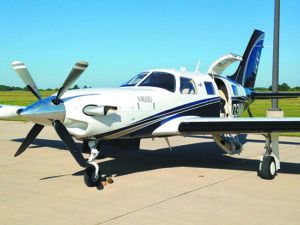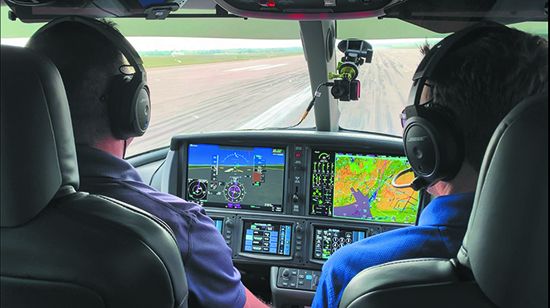Like the preowned piston market, the turbine market can be, as one sales pro put it, “like the Wild West.” For an uneducated buyer putting a small turbine in the hangar for the first time, there comes a risk of losing a small fortune. There’s truth to the old saw that just because you can afford to buy it doesn’t mean you can afford to maintain it, and that means buying it right—even if it means paying a premium for something close to so-called turnkey (I don’t think any turbine can be a turnkey experience—your wallet will be open from the first time you close the cabin door). As in the piston world, turbines with avionics upgrades, low-time engines and paint and interior mods fetch top dollar. And some are simply more desirable because of built-in capability, including the latest avionics tech.
One example is the second-gen Cirrus SF50 Vision Jet—its Garmin G3000-based Perspective Touch+ avionics suite is pictured to the right. Later models have Safe Return, which is Garmin’s built-in Emergency Autoland system, which also includes autothrottle. Not all are equipped with both. Ohio-based Lone Mountain Aircraft was listing a 2021 loaded with the Elite Package and cargo extension options. Just breaking in at 410 hours, there’s around 700 hours remaining on an airframe and engine warranty. The asking price was $3.15 million. It also had a first-gen 2018 Vision with 875 hours total time with the gen-two wing mod and cabin soundproofing upgrade. It was priced at $2.29 million. Lone Star—selective in what it sells—is at the top of the preowned Cirrus food chain, with a reputation for treating the buyer right long after the sale.

If even an early Vision Jet breaks the budget by a cool $1.5 million, look to the Piper turboprop market where you’ll find a wide variety of PA-46-500TP models. The earliest birds are from 2001, and the Summer 2023 Aircraft Bluebook suggest a typical retail of $600,000. The respected Cutter Aviation in Arizona had one with 2700 hours total listed for $865,000. TBO for the PT6A-42A is 3600 hours and if it needs it, roughly $500,000. Some early and lower-priced Meridians sport the Meggitt flight displays and S-TEC autopilots, while others with the latest Garmin gear are priced north of $1 million. Garmin G1000 avionics were standard in 2011 Meridians on up through the M500 models, boosting typical retail prices to around $1.5 to $1.8 million. The 600-SHP M600 models have Garmin’s G3000 avionics and hover around the $3 million mark.
And nobody would shop the preowned turboprop market without considering a Socata (now Daher) TBM. The earliest—the TBM700—is from 1991. Bluebook pegs these workhorses at $1million for early ones to around $1.8 million for the TBM 700C2. The respected Aerista, with salespeople located around the country, had a 5000-hour 1993 TBM700. Its PT6A-64s were overhauled 1500 hours ago (TBO is 3500 hours) and the airplane has modern Garmin avionics, good-looking paint and a luxurious interior. It’s a fair value at $1.5 million.
And if the skills and fuel budget can handle a twin turbofan, take a look at the Cessna Citation CJ1 and Mustang 510 market, where prices can vary widely depending on engine times and refurbishments. The Bluebook says a 2006 Mustang might retail for around $1.8 million. I found a 2007 model with 3700 hours total time and freshly overhauled Pratt PW615Fs that are on a PowerAdvantage+ engine maintenance program. The 510 is a Garmin G1000 airplane and this one had the latest G1000 NXi upgrade. Brace yourself—later-model, low-time 510s flirt with $3 million. The earliest Williams-powered CitationJet 525 is from 1993. We found a 1996 525 with fresh paint and interior priced at $1.8 million—pretty much right at Bluebook suggested retail. The engines have about 300 hours to go before the 3500-hour TBO. Save every bit of $700,000 for that invoice.
I’ve seen it before—first-time turbine owners unloading the airplane within a year because of a hasty buying decision that had them writing huge checks they didn’t anticipate. One key to avoiding buyer’s remorse on a preowned turbine purchase is working with a sales firm that you trust—one that sells a lot of turbines and one that can explain real-world operating expenses based on how you plan to operate. You’ll quickly discover that compared to the piston world, turbine ownership is a whole new league in expenses and complexity. Tame it by starting small. —Larry Anglisano


